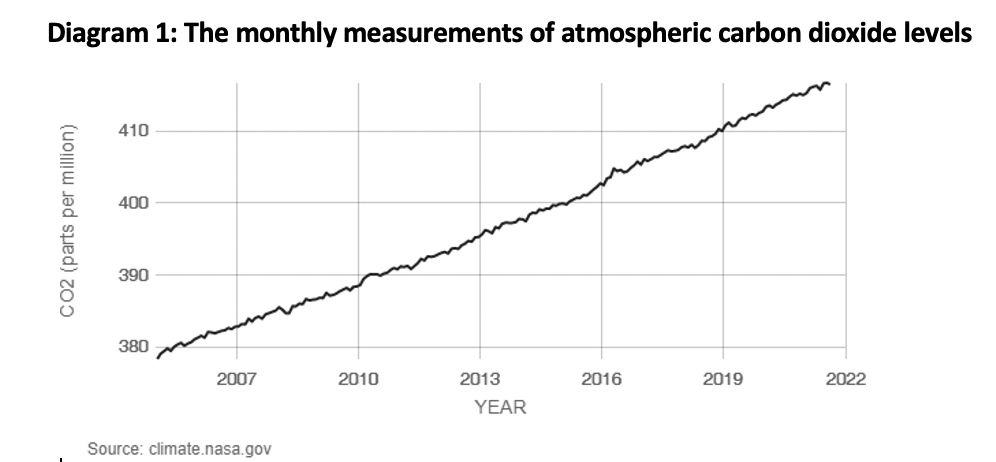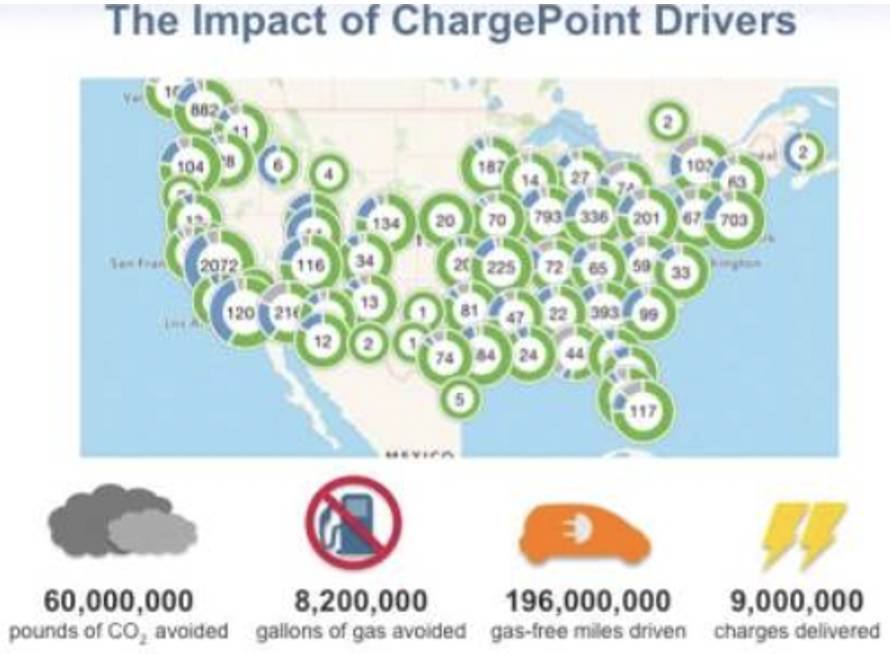The impact of climate change is becoming more visible and has been felt by more people around the world. It has brought about the increased occurrence of wildfires, storms and longer periods of drought. Shrinking icebergs and rising sea levels are contributing to more floods, especially in coastal cities.
The increase in global average temperature and sea levels is the result of a steady rise in the level of carbon dioxide in the Earth’s atmosphere. Between 2005 and 2021, there has been a 10% increase in carbon dioxide levels, as seen in Diagram 1.

Green Economy Initiatives Are Underway
The science behind climate change is evaluated by the Intergovernmental Panel on Climate Change (IPCC). It is an intergovernmental body of the United Nations (UN), tasked with assessing the causes, impacts and risks of climate change, and providing response options for mitigation and adaptation. The IPCC leads and organizes meetings and events to communicate its findings and methodologies. For example, the body co-sponsored a workshop on biodiversity and climate change in December 2020 to explore the connections between biodiversity and climate. There were several international policies established to address climate change. The Montreal Protocol was introduced to cut the production of ozone-depleting materials, such as chlorofluorocarbons.
It established a regularly reviewed timetable that outlines the phase-out dates of ozone-depleting materials The UN Framework Convention on Climate Change (UNFCCC) was established to support the global response to climate change, through global discussions on the stabilization of greenhouse gas concentrations in the atmosphere. From the UNFCCC, the Kyoto Protocol and Paris Agreement were introduced. The former outlines the requirement for developed countries to reduce their carbon emissions by an average of 5% from the 1990 levels. Under the Paris Agreement, countries pledge to reduce carbon emissions with the goal of keeping the rise in global temperature to below 2°C above preindustrial levels, while striving to achieve net-zero emission by 2050.
The global industry has been adjusting its processes and equipment. Many organizations are adopting energy conservation practices and paperless offices by leveraging digital technology. One example would be the sieving out of plastic packaging.
2. ICT Industry Initiatives
The Information and Communications Technology (ICT) industry is making noticeable contributions to energy consumption and emission of greenhouse gases. According to the Global Enabling Sustainability Initiative (GeSI), the ICT sector is expected to account for up to 20% of the global electricity consumption levels by 2030.
The green development initiatives for the ICT industry can be broken down into several aspects, specifically hardware, software and processes. In terms of hardware, the main emphasis would be the evaluation of the equipment and tools used by ICT organizations. Companies start by understanding the energy consumption levels of their equipment, followed by adjustments to procurement policies and establishing energy conservation parameters for new purchases, such as replacing desktops with laptops, which consume up to 90% less electricity. Organizations have also implemented recycling programs to promote responsible waste management for old electronics, where improper disposal could aggravate the emissions of chemicals and greenhouse gases.
For example, Sprint (United States) established its Buyback Program to support responsible electronic waste management. It purchases back mobile devices for recycling by certified recyclers or for refurbishment. Amazon’s (United States) recycling program encourages its customers to recycle their devices and accessories, with all related costs are covered by the company.
In terms of software, the ICT industry has also seen numerous initiatives, such as the development of electronic working solutions. For example, video conferencing tools facilitate online collaborations remotely and reduce traffic on the roads. According to the GeSI, this could help save more than 100 hours of travel time annually per individual. An expected 67% reduction in travel emissions could be achieved. Monitoring applications are also adopted by the industry to provide real-time energy usage patterns and prompts for organizations to make quick adjustments in their operations.
In terms of processes, a prominent topic for the energy-intensive ICT industry has been the adoption of renewable energy. Major ICT players are increasingly leveraging renewable energy sources, such as solar and wind, in reducing their carbon footprints. For example, Google’s investments in renewable energies include a solar plant in Chile, and a wind farm in Sweden.
A major program that drives the ICT industry’s efforts in adopting green practices is the Momentum for Change initiative launched by the UNFCCC. The initiative recognizes and showcases green transformational solutions that are developed by ICT organizations, such as Electric Vehicle (EV) charging. For example, the Green Credit Card is an initiative introduced in South Korea to encourage the adoption of a low-carbon lifestyle. Users are awarded points for taking public transportation and making paper-less transactions, which can be exchanged for cash. This is a good avenue for companies to establish their presence in the global industry by demonstrating their green credentials.
3. Innovations
The existing technologies and practices in the ICT industry are addressing climate change by enabling the reduction of greenhouse gas emissions, and helping companies adapt to the impacts of climate change. ICT innovations are being leveraged to monitor environmental variables, such as soil condition in the agricultural sector, which could improve the efficiency of water resource management. With rising global temperatures, this ICT application would enable precision farming by using the environmental data generated.
Emerging technologies, such as Artificial Intelligence (AI) and digital twins, could produce promising solutions to address climate change. For example, the material science sector could leverage AI and Machine Learning (ML) to produce structural materials and products with less raw material inputs, such as steel and cement. The production of these raw materials contributes to more than 10% of the global greenhouse gas emissions. Therefore, the development of new, eco-friendly materials would reduce the existing carbon footprint.
Another promising aspect is “green mobility.” The transportation industry contributes to around 24% of the global carbon dioxide emissions, with freight and passenger transportation accounting for about half of this. The development of autonomous vehicles fundamentally relies on ML to enable the prospects of reducing congestion through optimizing travel routes, in turn, reducing the energy consumption during the journey.
Future development plans for innovation should be directed toward the goal of achieving net-zero emissions. Innovations from designing with greener materials to deploying multi-hazard warning systems are critical in helping the world address climate change. More data and analysis are required to provide insights on the mitigation of climate change, enabled by advancements in technologies, such as AI. Therefore, developing and implementing future innovations should encompass environmental considerations with a higher significance.
4. The Potential Benefits of Going Green
The adoption of green ICT technologies and practices is enabling the reduction in carbon emissions across other industries. During the recent HUAWEI CONNECT 2021, Huawei’s rotating chairman, Eric Xu, highlighted several pledges from the European Union (EU) and China on attaining carbon neutralities. The benefit of adopting ICT technology was also brought up, which could potentially reduce industrial emissions by 12.1 billion tons; this is around 10X the emissions contributed by the ICT industry itself. A reduction in energy consumption by green innovations could also translate into cost savings. For example, smart metering solutions could allow a household unit to enjoy annual savings of around US$200 on its energy bill.
ChargePoint, is an EV infrastructure provider that offers smart energy management tools to drive the mainstream adoption of EVs. Its mobile application enables drivers to locate available charging stations and manage the charging sessions. This convenience eases the transition process from Internal Combustion Engine (ICE) vehicles to EVs. Diagram 2 below outlines the benefits that ChargePoint drivers have brought in addressing climate change, such as the reduction in 27.2 million kilograms of carbon dioxide.
Diagram 2: The Benefits of Adopting EVs (Source: ChargePoint)

ICT Can Support a Circular Economy
These environmental and economic impacts could benefit players in the ICT industry by reducing their operational expenses, so more budget could be allocated to Research and Development (R&D) functions to create and deploy new green technologies and innovations. Creating a circular economy that could be operated sustainably would allow the industry to mitigate and adapt to the effects of climate change. The ICT industry has enhanced connectivity and enabled many of the innovations mentioned in this article. Using ChargePoint as an example, the lack of efficient connectivity could potentially impact its operations. Drivers would not be able to locate charging stations to charge their vehicles, and worse, not be able to activate the charging process without their mobile application.
Without a doubt, there is an opportunity for the ICT industry to play a key supporting role in the global green movement.
The post The ICT industry can play an essential role in the green economy (Analyst Angle) appeared first on RCR Wireless News.
